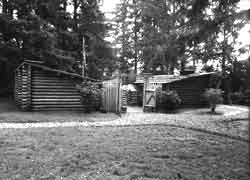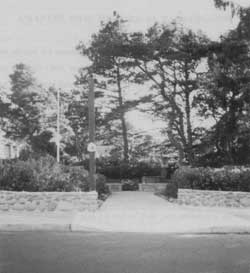|
Fort Clatsop
Administrative History |

|
CHAPTER ONE:
INTRODUCTION

After reaching the Pacific Ocean in November, 1805, the Corps of Volunteers for Northwest Discovery moved south of the Columbia River to set up winter camp. They had chosen a place inland, a campsite that provided access to a fresh water spring and the Netul River for transportation, access to the coast for salt production and possible encounters with trade ships, had promising elk populations, and was removed from the harsh weather carried in from the Pacific Ocean. For three-and-one-half months, the members waited out the rain, hunting, making salt, compiling their journals and maps, and preparing for the journey home. One hundred fifty years later, the residents of Clatsop County celebrated the Lewis and Clark Expedition by building a replica of their winter quarters on the site long referred to as the "site of Old Fort Clatsop."
It is this community-sponsored replica that is the central focus of Fort Clatsop National Memorial. Since the turn of the century, Clatsop County settlers had sought national recognition of the site. Established in 1958, this unit of the national park system has grown to be one of the most popular tourist attractions along the northern Oregon Coast. Visitation currently averages approximately a quarter of a million people a year. For thirty-five years, this park has endeavored to tell the story of the Lewis and Clark Expedition and its impact on the settlement of the Pacific Northwest.
GEOGRAPHIC LOCATION
The memorial is located off U.S. Highway 101 in Clatsop County in northwestern Oregon, six miles south of Astoria. The site sits along the Lewis and Clark River, south of Youngs Bay and four miles from the Pacific Ocean. The satellite Salt Works site is located 15 miles south of the memorial in Seaside, Oregon. The memorial totals 125.2 acres.
RESOURCES
Buildings at the memorial include a visitor center containing exhibits, a theater and multipurpose room, the Fort Clatsop Historical Association gift shop, public facilities, the administrative offices for the park and the association, and the Fort Clatsop Research Library, two employee residences, and a maintenance shop. Interpretive points of interest center around the replica fort, and include a canoe landing site and spring site, as well as the Salt Works site in Seaside. There is a small picnic area with covered shelters. Foot trails with natural history interpretive markers connect the memorial's interpretive sites. There is also a hiking trail.
Fort Clatsop has very diverse natural resources. The memorial environment consists of coastal conifer forest and estuarine wetland habitats, with well over 300 known species of plant and animal life. The climate is very wet, averaging about 75 inches of rainfall per year. The memorial's cultural resources include the fort and salt works replicas, a bronze statue, original art, and its artifact, natural specimen, and rare books collections. Limited archeological surveys have revealed the foundation of a 19th-century home and artifacts of 19th century settlement. As yet, no archeological evidence of the location of the original Fort Clatsop have been identified.
PURPOSE

Salt Works site, view from street, August 1994. (Photo by K. Cannon)
In considering specific events of American history, the Lewis and Clark Expedition is one of the most well known, as well as one of the most studied, U.S. explorations. The Expedition was the first exploration promoted and financed by the United States government. [1] Commissioned by President Thomas Jefferson, the Expedition was to explore and document the territory between the Missouri and the mouth of the Columbia River and map the area; determine a suitable water route to the Pacific; establish contacts with American Indian cultures and record information about those cultures; and scientifically document the plants and animals of the area, especially those of economic importance. To the expanding country that was then the United States of America, exploring the newly-acquired Louisiana Purchase and beyond marked the opening of new frontiers, knowledge, and opportunities. Entrepreneurs such as John Jacob Astor followed close on the heels of the Corps of Discovery and established American settlements and trade on the edge of the continent. Fort Clatsop, despite the fact that it was a temporary structure designed to keep the Corps sheltered until the worst of winter passed them by, was the first American military structure west of the Rockies. For three-and-one-half months, the fort was the first outpost of American overland penetration of the West Coast. During that time, the Corps displayed American culture and society to the local cultures. They lived by military organization, explored the environment and documented American plant and animal species new to science, wrote and copied their journals, made maps, entertained themselves with European and early American music and games, traded and interacted with the local native communities, complained about the weather and fleas, hunted, made buckskin clothing, produced salt, and waited. It was at this fort that Lewis and Clark contemplated their findings and planned the trek home. And it was this brief encampment on the Pacific Coast that helped give the United States a foothold into the Oregon Country. Long after the Corps left, their presence remained known to the local population. During the next one hundred years, when new Americans pushed into this corner of Oregon, they acknowledged and visited the site.
VALUES AND SIGNIFICANCE
The memorial was established
for the purpose of commemorating the culmination, and the winter encampment, of the Lewis and Clark Expedition following its successful crossing of the North American Continent Public Law 85-435, 72 Stat. 153)
Fort Clatsop National Memorial commemorates the Corps of Discovery's accomplishments and its impact on the development of a young, expanding nation. The memorial presents the history of the expedition and its significance to American and Pacific Northwest history as well as what life was like at the fort during the winter of 1805-1806. The memorial is also a testimony of the pride the local community has for their history and the value Americans place on the Corps of Discovery. Nearly two hundred years later, the expedition continues to capture the imagination of Americans. It is the significance of the Corps of Discovery to the history of the United States and its popularity that gives Fort Clatsop National Memorial its value.
PURPOSE OF STUDY
This administrative history is an examination of the memorial, from local preservation efforts to its designation as a national park unit, its management history as a national park unit, and its growth since inception. The author will strive to show what issues have confronted park staff on a daily and recurring basis and how those issues have shaped the park for its first thirty-six years. This history is designed to be a practical document that shows how the park has been managed over time and how the memorial has met its goals, without making judgments about past or present management practices.
Research for the history has been based primarily on the park archive, compiled by the author during the summer of 1993. The park archives consists primarily of materials generated by the staff of Fort Clatsop over the years, as well as materials from the Western and Pacific Northwest Regional Offices of the National Park Service. Materials regarding the site prior to establishment as a memorial came from the files and archives of the Oregon Historical Society and the Clatsop County Historical Society. Oral history interviews were conducted with members of the community who were involved in the reproduction of Fort Clatsop and its designation as a national memorial, past park superintendents and staff, and the current memorial staff The intent of this administrative history is to help future staff and superintendents understand the management history of the park and help them better understand the issues they may face and need to resolve.
| <<< Previous | <<< Contents >>> | Next >>> |
focl/adhi/adhi1.htm
Last Updated: 20-Jan-2004